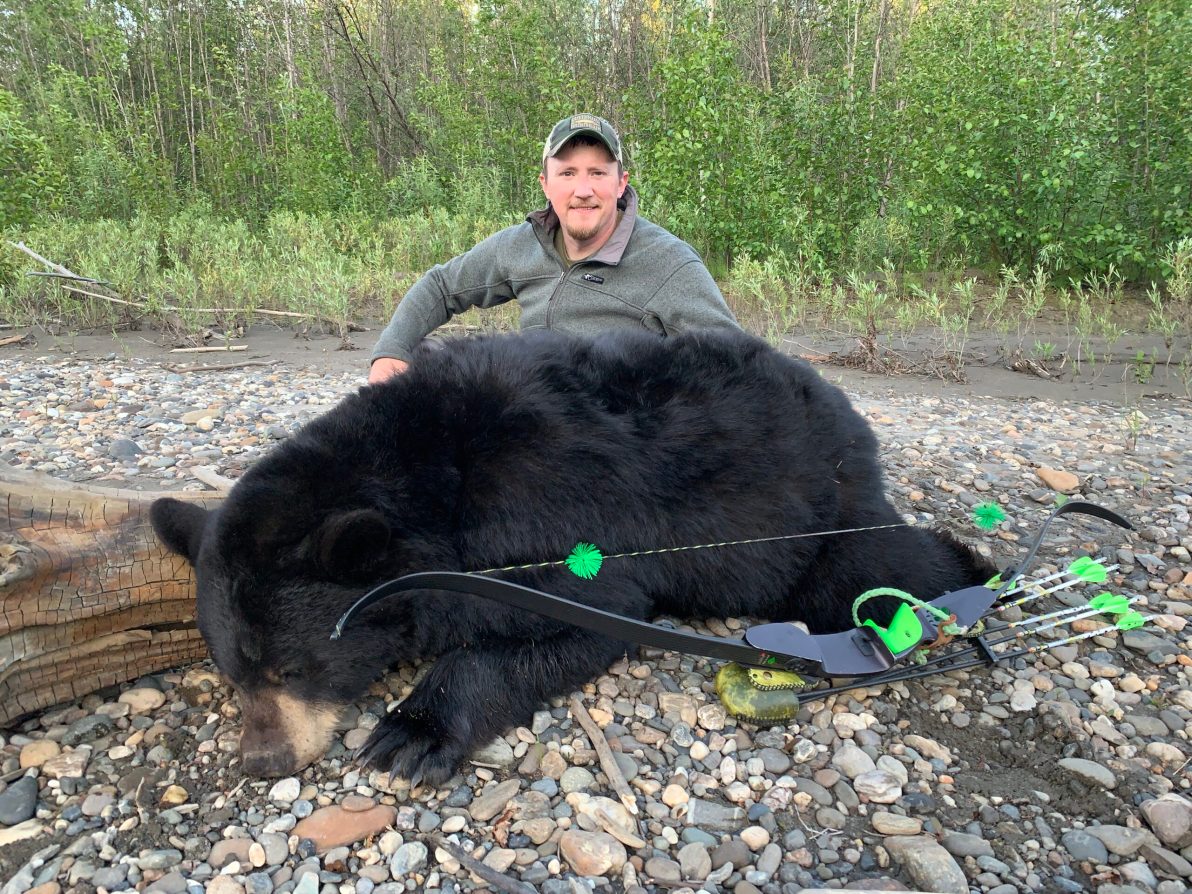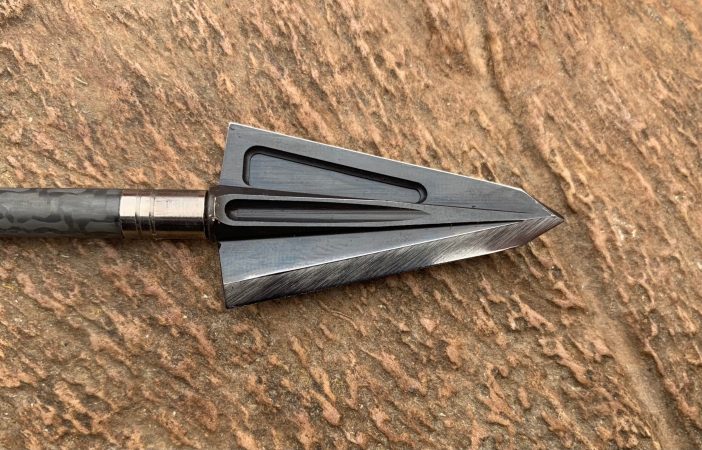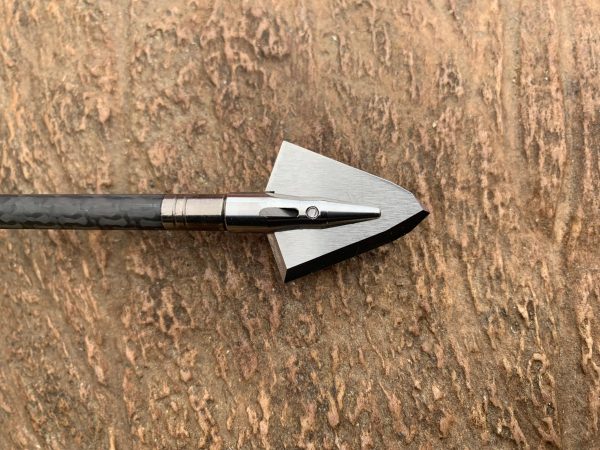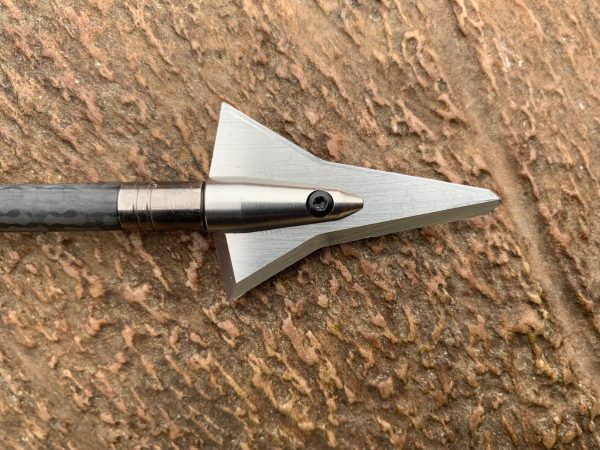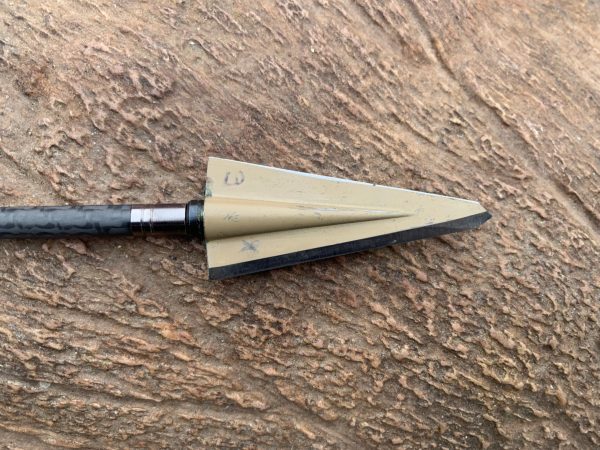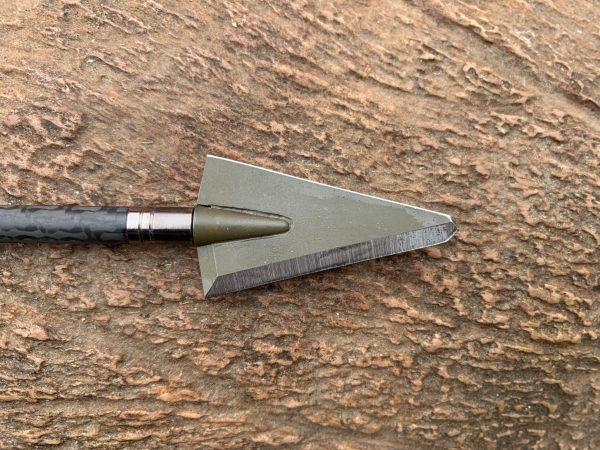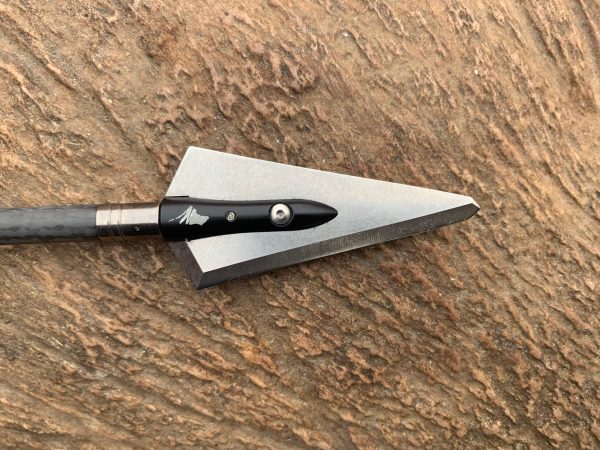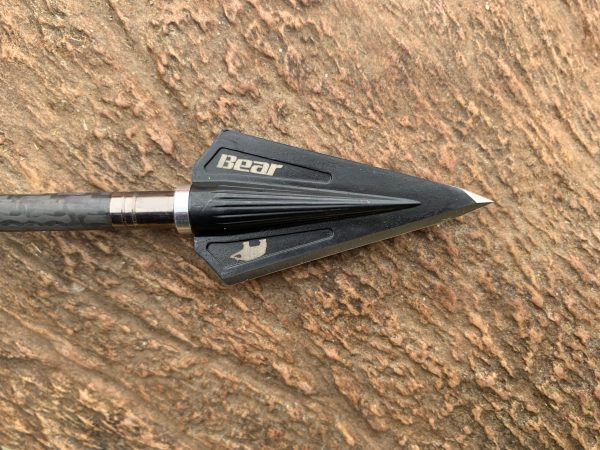We may earn revenue from the products available on this page and participate in affiliate programs. Learn More ›
Single bevel broadheads have leveraged simple technology to boom in popularity over the last decade—right alongside the most advanced archery tackle. Debating the best type and style of broadhead can be contentious, and it requires that you consider a number of factors. Many hunters stake their bets on the simplicity and reliability of fixed-blade broadheads, and single bevels are chiseling a strong foothold in the market. I’ve been a fan and proponent of single bevel broadheads for a long time, and I’ve gathered some of the best and most popular to help you choose wisely.
- Best Overall: RMS Gear Cutthroat Broadheads
- Best Four Blade: Iron Will Single Bevel
- Best Value: Helix FJ2
- Grizzly Single Bevel
- Abowyer Bonehead Carbon
- Grizzly Stik Samurai
- Helix FJ2
- Bear Razorhead Single Bevel
What Is a Single Bevel Broadhead?
A single bevel broadhead has edges that are only ground on one side of the blade—often at 25 degrees. Unlike most knife edges or the edge of any given broadhead, where the grind is even on both sides of the blade, the reverse side of a single bevel edge is flat. Grab the scissors out of your junk drawer for an example of what a single bevel broadhead’s edge looks like.
Single Bevel Broadhead Advantages
Fans of single bevel broadheads credit them with three main advantages:
- They can be made sharper than conventional edges
- The edge spins as it is cutting
- They penetrate better through heavy bone
Because the angle of most single bevel broadhead edges is 25 degrees, they can be made sharper than that of conventional edges—even a double bevel edge with a 15-degree grind on each side is still a 30-degree edge. Many knives and broadheads have edges that are 20 degrees or more on each side.
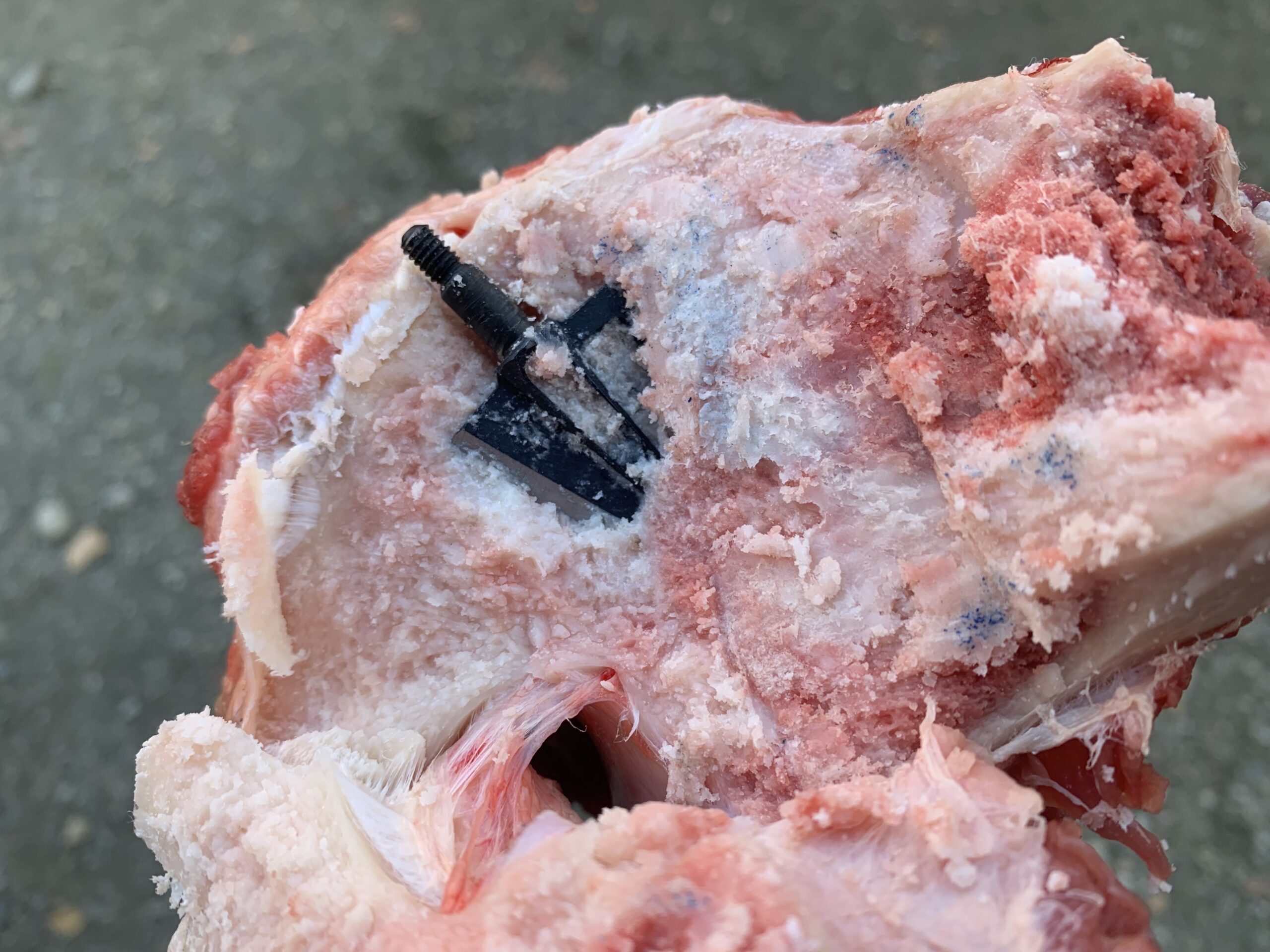
As a single bevel broadhead is pushed through a medium, the edge leverages and rotates the broadhead in a spiral. Double bevel broadheads stop the rotation of the arrow and plunge straight through. If you hold an arrow loosely in your fingers and press a single bevel broadhead through a piece of paper, you’ll feel it begin to rotate and leave an S-shaped cut. This rotation and edge design reduces resistance and helps the broadheads split heavy bone and penetrate deeply.
The foremost proponent of single bevel broadheads is Dr. Ed Ashby, who conducted years of testing and experimentation on arrow lethality and penetration, and his work is often referenced by fans of single bevel broadheads.
Read Next: Single Bevel Broadheads: Everything Bowhunters Need to Know
Keys to Making Single Bevel Broadheads Work for You
The two biggest complaints from new users of single bevel broadheads is that they plane off course and they are hard to sharpen. With a well-tuned and properly-fletched setup, I’ve found the opposite to be true. There are a couple of key things to consider.
Spinning, Tuning, and Fletching
With a properly tuned setup, I find single bevel broadheads to fly better and straighter than field points. There are some key factors for making this happen:
- Bow and arrows must be properly tuned
- Broadheads must be straight and spin true
- Use a helical fletching that matches the bevel (right or left)
Your bow needs to be in tune, sure, but your arrow spine, shaft length, and point weight all need to be dialed in and producing a straight-flying arrow. Changing spine, arrow length, point weight, or even switching to different arrows with the same spine will require re-tuning.
Fletching will mask poor tuning and arrow flight with field points, and even some broadheads, but a single bevel point cuts and rotates through the air in the same manner that it does through flesh. If your arrow is flying crooked, the broadhead will cause the arrow to plane and veer off course.
With your point weight and arrow length dialed in, check to ensure that each point spins true and isn’t bent or wobbling. As the arrow spins through the air, a broadhead that’s out of whack can cause the same planing issues as a poorly tuned arrow.
Even in compound bows, it’s helpful to use helical fletching that matches the broadhead’s bevel. You’ll find single bevel broadheads in either “right bevel” or “left bevel” configuration—which simply indicates which side of the blades the grind is on. Use a “right wing helical” fletch for feathers or vanes for right bevel, and “left wing helical” for left bevel. This way, both the vanes and broadhead will spin the arrow in the same direction.
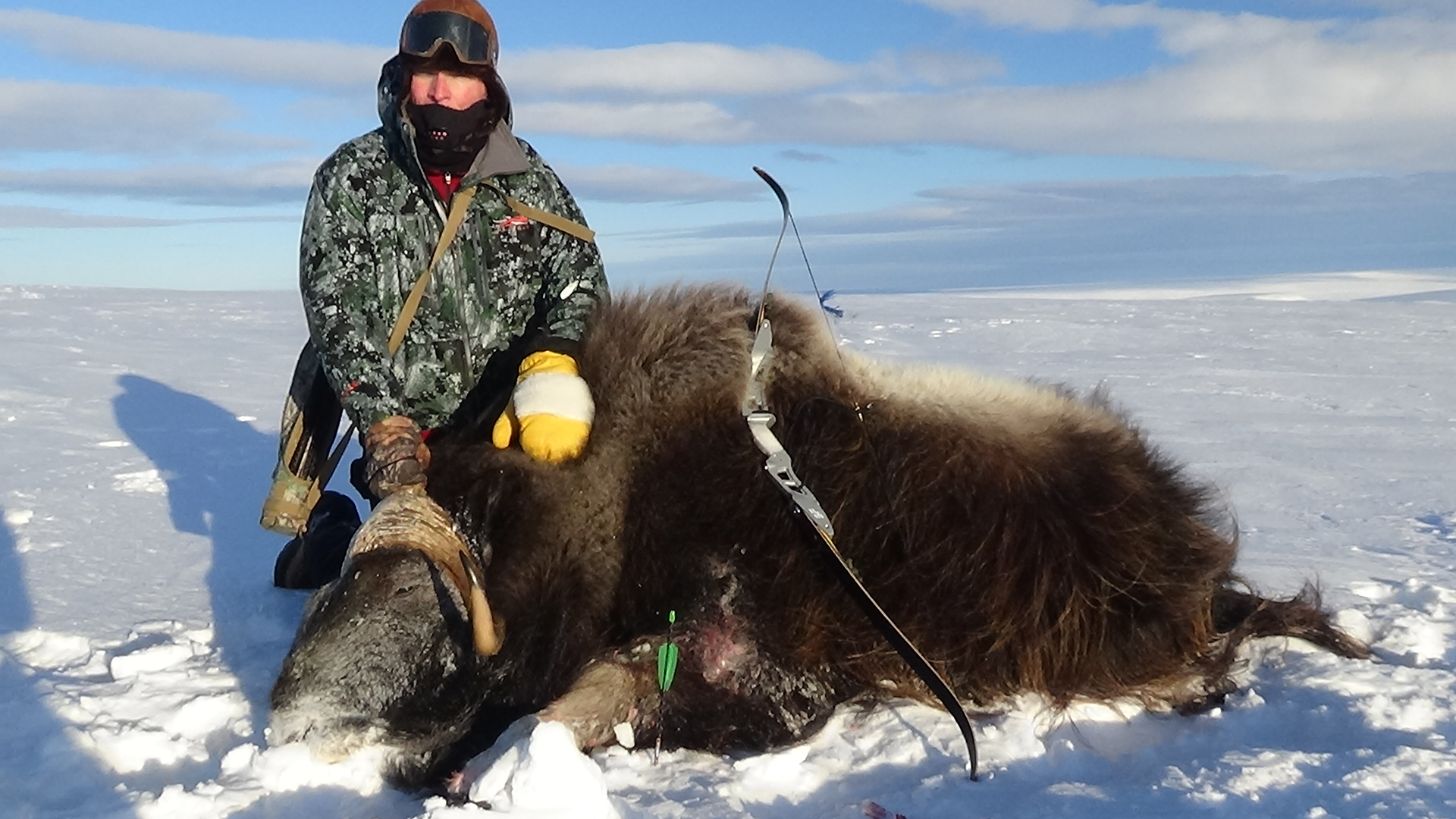
Sharpening Single Bevel Broadheads
Unlike throwaway broadheads, many single bevel broadheads are built to be used over and over—and they need to be built tough to break bone. Some single bevel points come razor sharp from the manufacturer, but many require some end-user sharpening. Although some claim that single bevels are difficult to sharpen, they’re actually quite easy. Even some of the rougher points can be made shaving sharp with only a strop and some polishing compound. For chipped or really rough edges, a KME sharpening jig and flat stone, or a system like Work Sharp Precision Adjustable sharpener make sharpening single bevel broadheads easy.
One of the key points for getting single bevel broadheads terrifyingly sharp is to ensure that your stone or strop is working all the way out to the edge of the blade. Some broadheads have a slightly concave grind that requires resetting with a sharpener to achieve maximum sharpness. Another point is to resist grinding on the back side of the edge. Sharpening will roll a burr over the edge. Laying the blade flat on the back side, and gently straightening the burr is all that’s needed. Don’t grind an additional bevel on the reverse side. Finishing your edge with a strop will help you get the broadhead so sharp that it cuts hair with only a light touch.
Read Next: Best Knife Sharpeners
Best Single Bevel Broadheads: Reviews and Recommendations
Best Overall: RMS Gear Cutthroat Broadheads
Key Features
- Design/construction: One-piece, machined
- Material: Carbon Steel or S7 tool steel
- Weight range: 125-250 grains
- Cutting Diameter: 1 ⅛ inches, or 1 ½ inches (wide cut version)
- Price: $25-$38 per head
Pros
- Durable construction—no welds, braze lines, or components to fail
- Easy to sharpen
- Excellent flight
- Lifetime guarantee
Cons
- Steel can corrode and needs to be oiled
- Sharpening costs extra
After Tommy Clum of Rocky Mountain Specialty Gear had a single bevel broadhead break when shooting a moose, he set out to a design a broadhead with his brother Dan, and father Tom Sr. The Cutthroat is the result. It’s a one-piece, machined point that features a wide chisel tip to resist curling, 25-degree edges, and grooves in the blade and ferrule. They are available in a variety of weights and in either carbon steel or S7 Tool steel, which is highly impact resistant.
It would be dishonest to omit my friendship with the Clums when pumping the Cutthroat as my personal favorite broadhead, but it’s a product that stands on its own with few equals. These broadheads vary in price based on size and material, and are sold in packs of three. I’ve killed quite a few bears with these ranging from 150- to 250-grains. They’ve always had excellent penetration, even through bone. In a couple of cases, I’ve shot multiple animals with the same broadhead. They usually require only a light stropping.
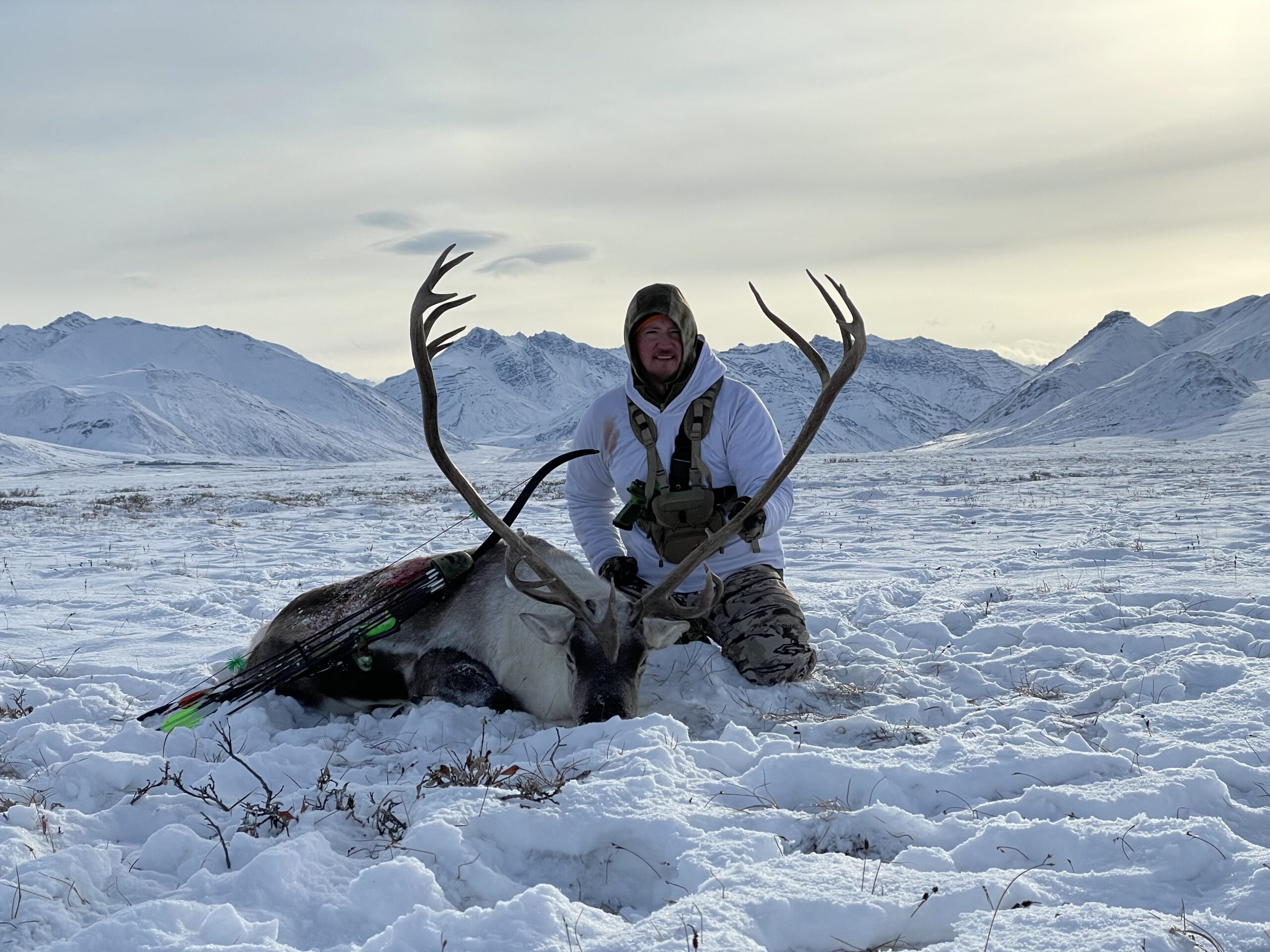
I shot both the standard and wide-cut Cutthroats into the heavy moose leg bones, and both buried completely up to the arrow. The bone rolled edges on the wide cut point, but it was still serviceable. I shot a 150-grain standard Cutthroat from my 70-pound compound with a 650-grain arrow directly into the ball at the top of the front leg bone (the one that the scapula connects to). It’s essentially four inches of solid bone, and I had to chisel the bone apart to retrieve my point. The edge took no discernable damage and was still shaving sharp.
Cutthroat broadheads are premium points that vary quite a bit in price depending on the weight and steel. They’re available in both screw-in and glue-on configurations too. The wide-cut model is 1 ½-inches wide and is one of the most devastating broadheads I’ve used. All cutthroats can be sharpened easily, but they can also rust easily. It’s important to coat the carbon steel with oil, Vaseline, or something like Valkyrie Archery’s Jag Wax. The heads have a lifetime guarantee, so if you ever break one, they’ll replace it, no questions asked.
Best Four Blade: Iron Will Single Bevel
Key Features
- Design/construction: Assembled ferrule, blades, and bleeder blades
- Material: A2 Tool Steel, titanium or stainless ferrules
- Weight range: 100-250 grains
- Cutting Diameter: 1 1/16 inches
- Price: $40-$45 per head
Pros
- Precision engineered and constructed
- Superb durability
- Excellent flight
- Sharpest broadheads out of the package
Cons
- Very expensive
Iron Will broadheads were born of the mind of Bill Vanderheyden from the desire for a better, more dependable point. Iron Will first produced double bevel broadheads, but now has single bevels in a variety of weights. Their single bevel broadheads have essentially the same robust shape and durable components as the double bevels, but with single bevel edges on both the main blades and bleeder blades. They also offer a version without bleeder blades. Because the bleeders are also single bevel, they’re less likely to inhibit penetration, and cut in the same direction as the main blades while opening up a larger wound. The back side of the main blades is sharpened in a single bevel too, so that if an arrow is pulled backwards from a wound, it will continue to cut.
The heads are tipped with a tanto-style tip to resist breaking or curling, and leverage the blade’s force into bone. The A2 Tool steel blades maintain a very sharp edge, and can be re-sharpened—though the process is a bit more tedious than with many other single bevel broadheads. They’re treated and tempered to provide an optimal balance of hardness without being too brittle. I did find that glancing blows to moose leg bones would knock chunks out of the edge where carbon steel points would simply roll. The point remained serviceable and on a direct hit, buried up to the threads in the bone.
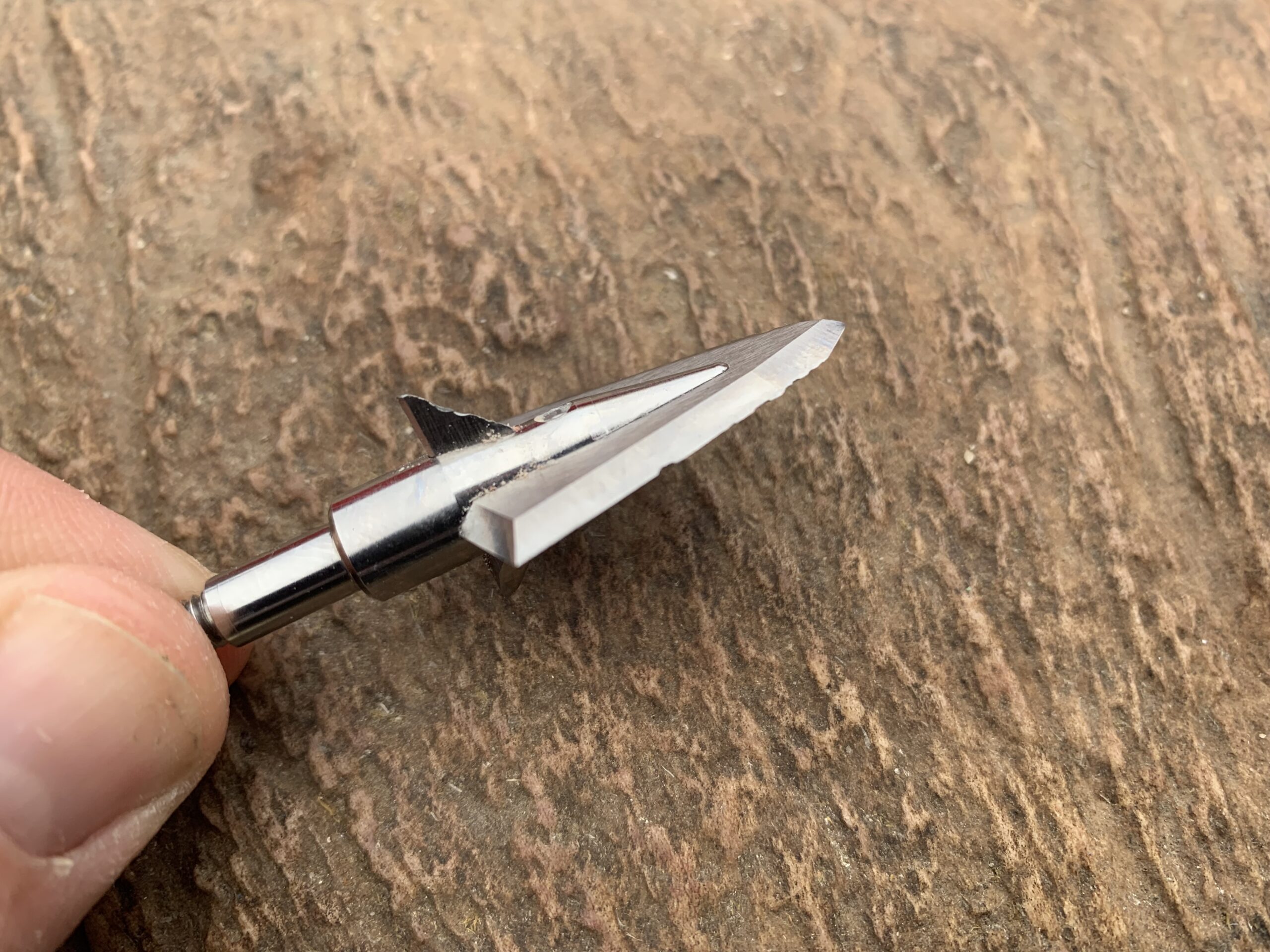
The blades are fixed into the ferrule with a single torx-head screw, and the ferrules are either titanium or stainless steel depending on the weight of the point. Iron Will Single Bevels come at a high price, but if you’re looking for the best that money can buy, these should be right at the top of your list.
Best Value: Helix FJ2
Key Features
- Design/construction: Two-piece, aluminum or stainless ferrule
- Material: Stainless steel
- Weight range: 100 to 225 grains
- Cutting Diameter: 1 ⅛ to 1 5/16 inches
- Price: $22 per head
Pros
- Deep-penetrating point
- Strong stainless blades
- Wide variety of weights
Cons
- Mine didn’t come hunting sharp
- Not as easy to sharpen as other single bevels
The Helix broadhead is one of the first single bevels I heard about. An outfitter I worked for told me how quickly one of his clients had killed a huge brown bear while using one, and the large blood trail it left. That stuck with me. Helix is now owned by America’s Best Bowstrings, but they’re still producing the uniquely-shaped single bevel heads, which have a long, narrow tip, then flare outwards dramatically for the last third of their length. This is intended to balance penetration with a wide wound channel. The stainless blade is secured to a stainless or aluminum ferrule (depending on weight) with a single screw, and the back edge of the blade is beveled as well. Like most single bevels, edges are 25 degrees, and the tip is chiseled. This point didn’t take any significant damage or edge rolling when shot into the moose’s leg.
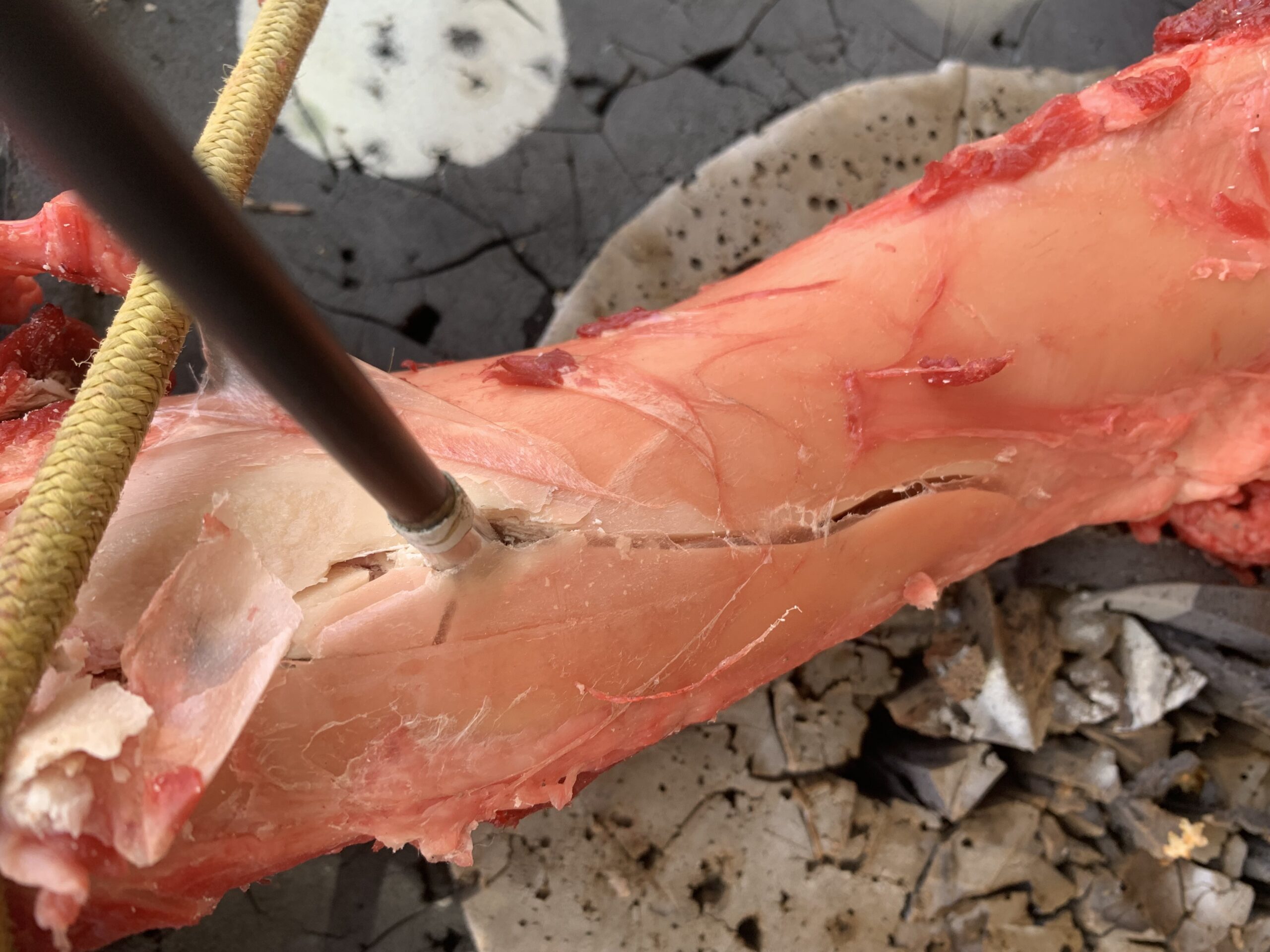
Helix broadheads generally fly really well, and aren’t too bad to sharpen—though the pack I just bought wasn’t very sharp. All edges of the broadheads still had a visible burr. This is no biggie for an experienced sharpener, but if you’re expecting razor-sharp, hunt-ready points, you’d better double check. These broadheads are priced pretty well at about $22 apiece, and Helix-specific sharpening tools are available.
Grizzly Single Bevel
Key Features
- Design/construction: two-piece, brazed (glue-on)
- Material: 1075 steel
- Weight range: 125-185 grains
- Cutting Diameter: 1 ⅛ inches
- Price: $13 per head
Pros
- Simple and effective
- Relatively durable
- Easy to customize
- Affordable
Cons
- Steel can corrode and needs to be oiled
- Does NOT come hunting sharp
Although availability is hit-or-miss, Grizzly single bevel broadheads are one of the classic designs that’s been around for decades. It’s one of the best single bevel broadheads for shooters who use wooden arrows or simply like to tinker and experiment with a variety of adapters and inserts. These are the first single bevel broadheads I ever used, and I’ve killed a number of large grizzly bears with them. These broadheads are made from two sheets of 1075 steel that’s spot welded and copper brazed together, with a 25-degree single bevel edge. They have a chiseled tip to prevent curling, and penetrate deeply with their long, slowly narrowing blade.
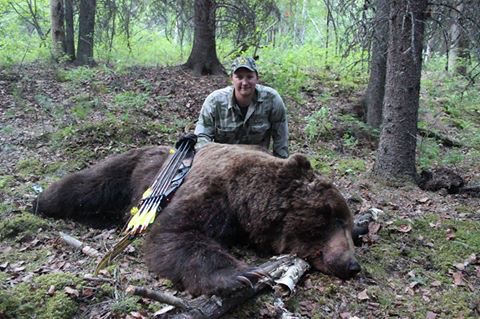
When I first started buying Grizzly broadheads, I’d have to throw away one out of every package of six for being out of true, or because of a defect, but the last years I was buying them, quality had improved dramatically. These are points you will have to sharpen before hunting with, but a KME jig or other sharpener and a strop will get them dangerously sharp. These points are available with aluminum screw-in adapters already glued on, but I preferred to order the glue-on broadheads and use them with steel adapters. I found that the Valkyrie Archery Viking Centerpin adapters made for an incredibly tough arrow.
These broadheads aren’t as tough as some of the precision-made, premium points, but I’ve never broken one on an animal. I watched my dad punch one through both shoulders of a bull muskox with his 50-pound recurve, splitting the near scapula from top to bottom.
Read Next: Best Broadheads
Abowyer Bonehead Carbon
Key Features
- Design/construction: two-piece, blade welded to ferrule
- Material: 1075 steel or 420 stainless
- Weight range: 150-200 grains
- Cutting Diameter: 1 ⅛ inches
- Price: $24 per head
Pros
- Simple and robust
- Comes razor sharp
- Consistent bevel and strong tip
- Easily resharpenable
Cons
- Steel can corrode and needs to be oiled
- Ferrule is short, weld is a weak spot
The Abowyer bonehead single bevel broadhead is a very traditional design that takes advantage of modern materials and precision welding. Abowyer has had clout in the single bevel game for many years, and these broadheads display the effectiveness, of a simple, gently-sloping design. They are a two-piece broadhead that you can get in 1075 carbon steel or 420 stainless steel, and consist of a threaded ferrule with a thick blade laser welded onto it. Like many other single bevels, it features a chiseled tip and a precision-ground edge. They also feature an un-sharpened bevel on the back of the blade to prevent the arrow from backing out of a wound channel, and this edge could be user-sharpened too.
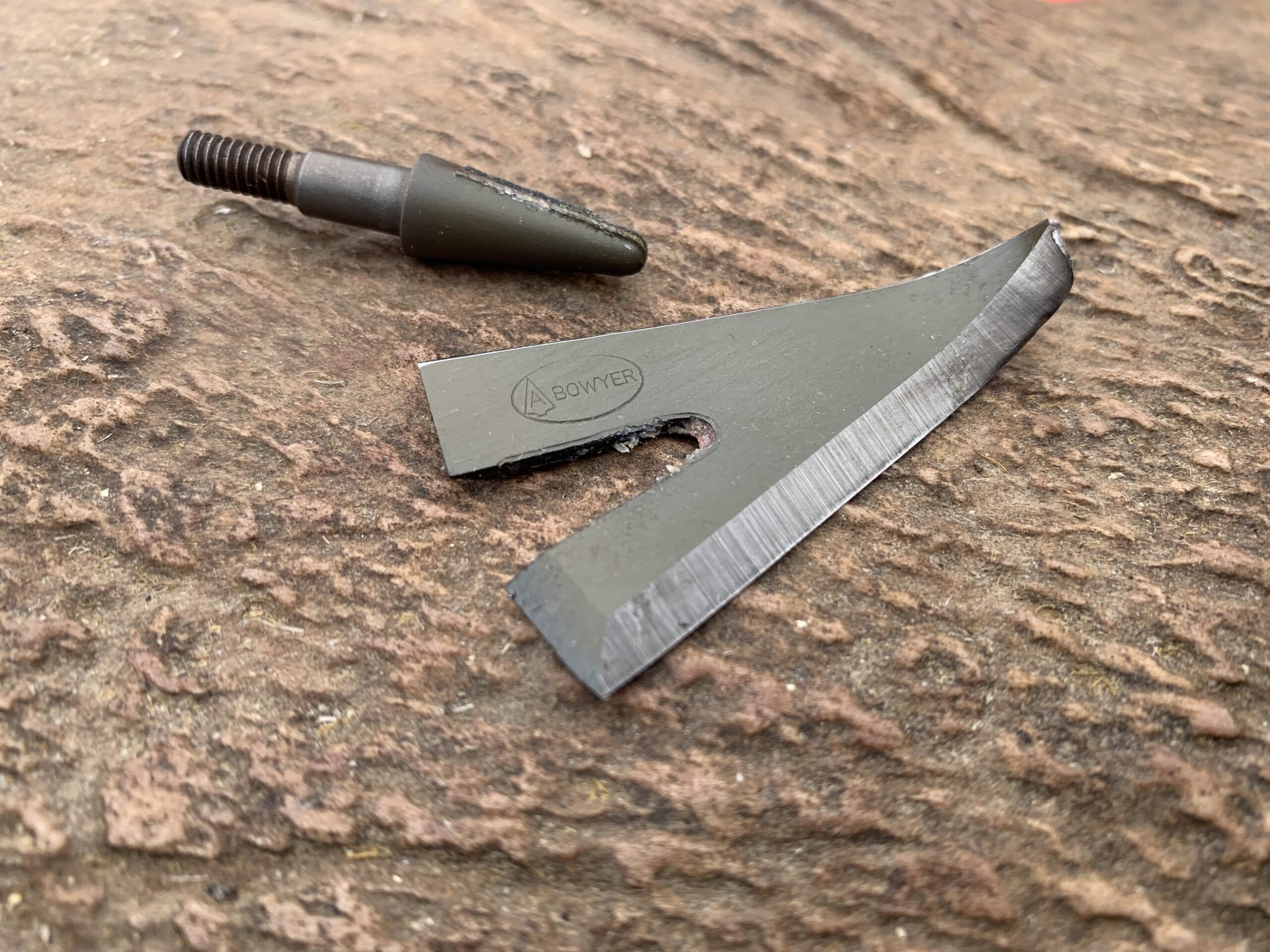
Bonehead broadheads come razor sharp, treated with oil, and with the edges protected by a removable dip plastic coating. If you choose the 1075 steel, make sure to keep the edges oiled in your quiver, and they will serve you well. Overall, it’s an excellent quality head, and the only obvious weak spot is the weld between the ferrule and blade. When shooting the moose bones, the point buried into the bone, but the weld snapped, sending the ferrule-tipped arrow back away from the target. When I recovered the point, the tip was curled over dramatically. This was an abusive test that wouldn’t dissuade me from using these points, but i’d be more careful about shot placement.
Grizzly Stik Samurai
Key Features
- Design/construction: two-piece, aluminum ferrule
- Material: 440C stainless
- Weight range: 125 or 200 grains
- Cutting Diameter: 1 ⅛ inches
- Price: $37 per head
Pros
- Efficient long design
- Strong 440C stainless blades
- Consistent bevel and strong tip
- Long ferrule secured by 2 screws
Cons
- Mine didn’t come very sharp
- Expensive
Grizzly Stik is synonymous with heavy-duty, deep-penetrating archery gear, and their Samurai single bevel broadheads are made in the fashion of those favored by Dr. Ed Ashby. They share the long, slender shape of several other single bevel points, and have an ultra-tough 440C stainless blade that’s secured to a long aluminum ferrule with 2 screws. These are available in 125- and 200-grain models, and both have consistent edge grinds and the chisel tip that single bevel points are known for. Though aluminum isn’t as strong as steel, the ferrules on these points are long and secured by two screws.
The Samurai is a premium single bevel point that’s advertised as coming razor sharp. Though the ones I bought were sharp enough to hunt, they aren’t nearly as sharp as I’d want them to be. I couldn’t get them to shave or cleanly cut paper. With some work on a stone and strop, I was able to get them scary sharp, but with 440C stainless, it’s not nearly as easy as with 1075 or other high-carbon steel.
Bear Razorhead Single Bevel
Key Features
- Design/construction: Two-piece, thread-in ferrules
- Material: stainless steel
- Weight range: 150 to 200 grains
- Cutting Diameter: 1 ⅛ inches
- Price: $20 per head
Pros
- Modular weight and consistent-spinning ferrule mounting
- Can be used as screw-in or glue-on head
- Stainless steel will resist corrosion
- Affordable
Cons
- Come moderately sharp
- Sharp tip might curl or break
The Bear razorhead is one of the most iconic mass-produced broadheads of all time, and Bear Archery is having another go at the plate with the new Razorhead Single Bevel. This is a totally new design for them, and the broadheads resemble classic double-bevel points like the Zwickey Eskimo. The stainless broadhead weighs 150 grains and can be glued onto wood arrows, but each pack comes with three different weights of modular thread-in adapters in magnesium, aluminum, and stainless steel to give you a maximum point weight of 200 grains. They also include three practice field points that thread onto the adapters.
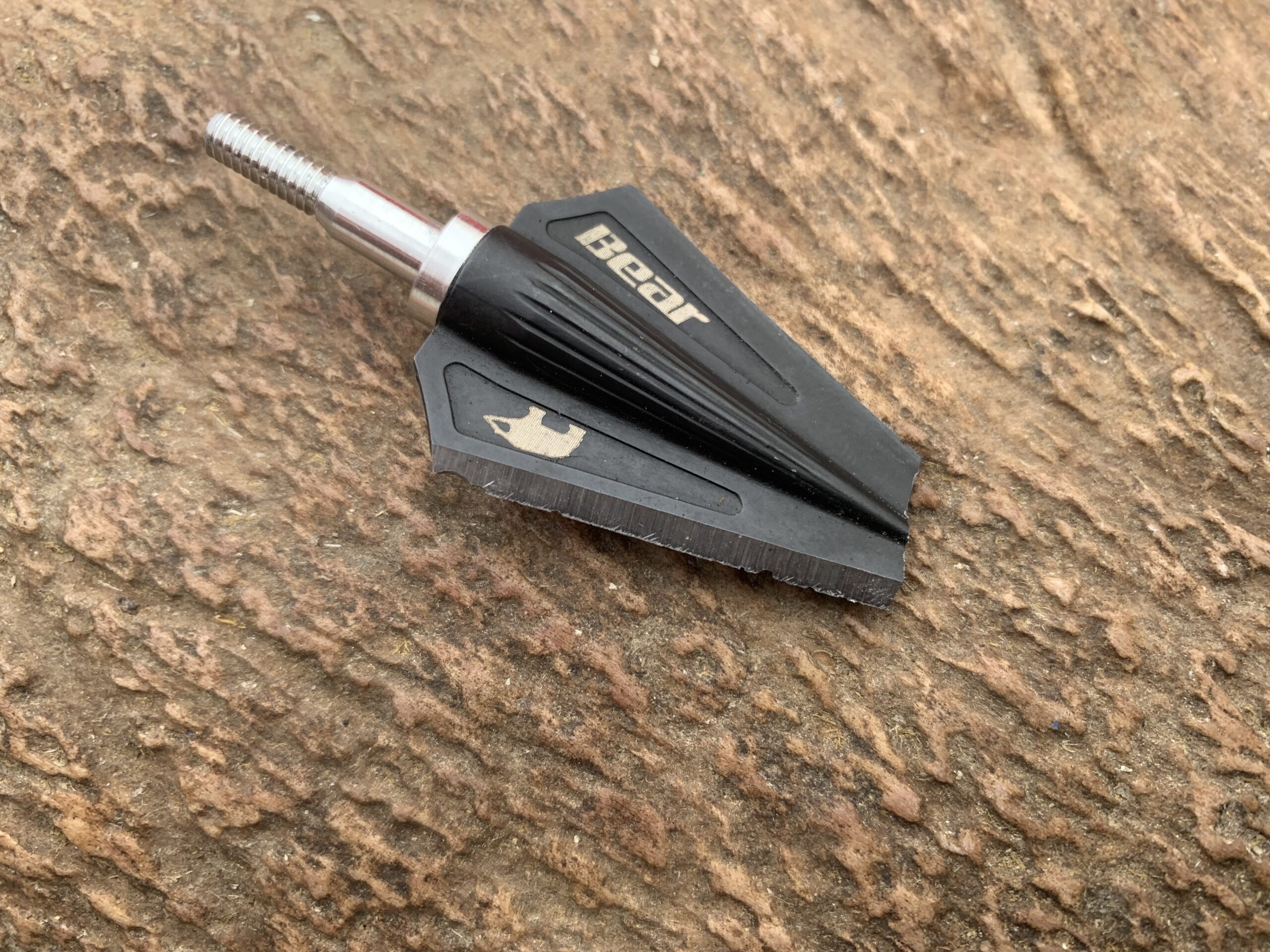
These single bevel broadheads are competitively priced, and probably appropriately durable. They come hunting sharp, but I’ll certainly spend some time stropping the points I’m going to use. The edges won’t shave and need a little work. The tip on these broadheads is notably more pointed than on most other single bevels, and in some cases it’ll likely roll or break when hitting heavy bone. When shot into a moose’s front leg bone, the broadhead penetrated an inch or so, then the tip broke off, sending the arrow flying back. Still, most hunters will find that these are an affordable option that work just fine with some good sharpening.
How I Chose the Best Single Bevel Broadheads
There are a wide variety of single bevel broadheads on the market today, which is good news to the consumer. They range from ultra-premium to very affordable, and each point has advantages and disadvantages. Differences include materials, style of construction, blade shape, and mounting options. Many heads are now screw-in, or available in screw-in configuration, but glue-on points can be combined with different adapter combinations to fine-tune weight and increase the durability of some of the more affordable points. Picking the best single bevel broadheads for you boils down to your equipment, budget, and tuning/sharpening skills.
Here I’ve highlighted some of the best single bevel broadheads that represent a variety of styles and price points, and for additional input, I shot each of the points into the heavy front leg bones of a freshly-butchered moose. Bones with 2 to 3-inch diameters aren’t something I expected the points to split or blow through, but I wanted to see any potential shortcomings or interesting results. Understanding the differences between these broadheads can help you make an informed decision, even if you don’t choose one of these.
FAQs
Single bevel broadheads are not hard to tune, but your bow needs to be tuned correctly with the same arrows and point weight that you will be shooting. Match the bevel of your broadhead with right- or left-wing helical fletching, and a well-tuned bow will shoot single bevel broadheads wonderfully.
The most important thing for getting your broadheads to fly well is to have your bow and arrows properly tuned. Heavier broadheads can give you some advantages, but only from a well-tuned setup.
A single bevel broadhead is generally very easy to sharpen, flies great, and rotates as it cuts, resulting in great penetration, and they’ll often split heavy bone.
Opinions vary, but according to Dr. Ed Ashby’s research, a long, gently-sloped single-bevel point is the most efficient, and deep-penetrating design. Key factors are also good tuning and a razor-sharp point.
Final Thoughts
Single bevel broadheads might seem intimidating if you’ve never used them, but if you know how to tune your equipment, they can be some of the most deadly, durable, and user-friendly broadheads you could pick. Once you learn how, they’re easier to sharpen and will often out-penetrate other points, and they’ll shoot great out of a well-tuned compound. If you’re looking to give one of the best single bevel broadheads a try, there’s never been a better time.
